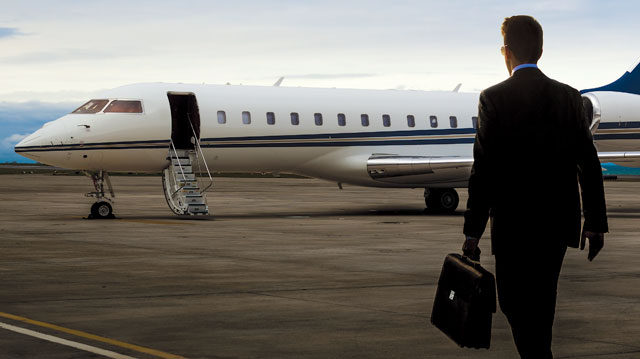
Robert L. Sumwalt, the longest-serving member of the National Transportation Safety Board, has been discussing the subject of safety ratings and audits of air charter operators in the wake of NTSB’s investigation of a fatal accident.
On Nov. 10, 2015, a Hawker 700 operated by Execuflight making a nonprecision localizer approach to the Akron Fulton International Airport in Ohio crashed into an apartment building. Both crew members and all seven passengers were killed. In a concurring opinion to the accident report, Sumwalt expressed his frustration with the many operational and procedural missteps investigators found. He described it as “a litany of failures – both in the organization and in the cockpit.”
Sumwalt also expressed concern “that an organization that had so many safety-related issues could have an ARGUS Gold rating and be Wyvern Registered,” referring to ARGUS International, Inc., headquartered in Cincinnati, OH, and Wyvern, Ltd., based in Yardley, PA. “Discriminating customers look to, and trust, such ‘seals of approval’ when selecting their air travel provider,” Sumwalt said.
In an effort to clarify what goes into those rating and registration labels, BAA contacted the principals of both companies, Joe Moeggenberg, the president and CEO of ARGUS, and Art Dawley, the CEO of Wyvern.
Both men acknowledged there could be confusion among charter customers about what the ratings mean and what goes into determining them, not to mention how charter operators may use those ratings in their marketing campaigns.
Moeggenberg noted that many Part 135 operators are not eligible to attain any ARGUS rating due to their poor accident/incident history.
Dawley said operators with a spotty safety record “have a reasonable expectation that they would probably not fare well in an assessment of their organization so we rarely come across those. Our reputation for stringent adherence to our standard is well known.”
To achieve an ARGUS Gold rating, operators must supply a lengthy list of data to ARGUS including information on their pilots and aircraft in their fleets. That data must be updated by the operator every 90 days, or “the operator loses their rating,” Moeggenberg said.
“We vet all that information,” Moeggenberg said, adding that in the last 12 months the company entered nearly one million pieces of data in their system. “We go through all the available databases to make sure there’ve been no accidents, incidents, violations. We do background checks on every pilot in our system. We take this very, very seriously,” he said.
“But the issue is, frankly, we do not do go on-site. The Gold operators provide us info, but it’s basically a desktop audit.” Dawley emphasized that “Wyvern only has one rating, the Wingman certification, and that is benchmarked against a publicly available standard that can be obtained on our website.” Wyvern uses the International Standard of Business Aircraft Operations (IS-BAO) Standards and Recommended Practices as the primary baseline criteria for the Wingman Program audit process.
Dawley said his company also has a “Wyvern Registered Program that allows an operator to provide data about FAA-approved and company specific documentation… but this program does not provide a safety certification rating. The Registered Data program is not intended to be anything but a repository for those non-audited operators that wish to supply information to Wyvern data clients and that has nothing to do with a safety certification or rating,” he said.
The information received from Wyvern Registered Program participants is run through the FAA’s National Vital Information Subsystem (NVIS), he said. Pilot and operator background checks are run on a daily basis via the U.S. government’s Freedom of Information Act request portal. Those checks also include accident/incident data and any enforcement actions against operators or pilots by the FAA.
Moeggenberg and Dawley each said they had talked personally with Sumwalt regarding his concerns of possible confusion among charter customers about their company’s programs.
Dawley said Wyvern “has embarked on an education campaign through our website to ensure that customers understand there is only one rating (certification) and that reference to any other data products should not be construed as having anything to do with safety assessments or certification.”
Moeggenberg said ARGUS has added a new “click-to-verify” button to their system. If a charter customer goes on the website of a charter operator who has an ARGUS rating, the new feature verifies what the rating is, and now provides a full explanation of what that rating means.
In addition to its Gold rating, ARGUS offers two others: ARGUS Gold Plus, and ARGUS Platinum. Operators seeking a Gold Plus rating also must cooperate with an on-site audit of the company’s maintenance and operations systems and procedures. The Gold Plus rating is approved only if the audit does not find any safety-of-flight discrepancies or findings.
To get an ARGUS Platinum rating, a charter operator must meet the Gold benchmarks and have undergone an on-site audit that reveals no adverse findings. Platinum operators also must have a functioning Safety Management System (SMS) and Emergency Response Plan (ERP) in place. Wyvern’s Wingman program also requires operators to have an SMS and ERP.
Charter customers should make it a point to visit both the Wyvern and ARGUS web sites to view the standards and benchmarks they use, and range of services that each offers. Both companies maintain lists of operators in their programs on those websites.
And both firms follow similar protocols for their on-site audits, employing two-person teams comprised of a flight operations specialist and a maintenance specialist who spend two days at the operator’s facility reviewing a wide range of records, procedures, and other pertinent data. Audits are repeated every two years.
Wyvern’s Dawley said there are slightly more than 2,000 Part 135 operators in the U.S. At the beginning of June, there were 382 Data Registered operators in the Wyvern system, and 142 Wyvern Wingman operators.
Moeggenberg reported similar numbers: 510 total operators in the ARGUS system, of which 120 have a Platinum rating.
When asked how expensive it is for an operator to obtain a Wyvern Wingman rating, Dawley responded, “committing to a higher level of safety and operational efficiency is a big investment, and not one all operators are willing to make.” But for those who choose to make that investment, “the return on investment is well worth it,” Dawley said.
Charter companies willing to have their data vetted or submit to outside safety audits suggest they are serious about safety. But ratings and audits are only a guide, not a guarantee.
If you are considering booking a charter with an operator you’re not familiar with, you owe it to yourself to do some research. Finding out the operator has an impeccable safety record and a SMS should provide peace of mind. Discovering the opposite should inspire you to find another charter operator. BAA
David Collogan has covered aviation in Washington, DC for more than four decades. This award-wining journalist is known as one of the most knowledgeable, balanced, wary, and trusted journalists in the aviation community.




